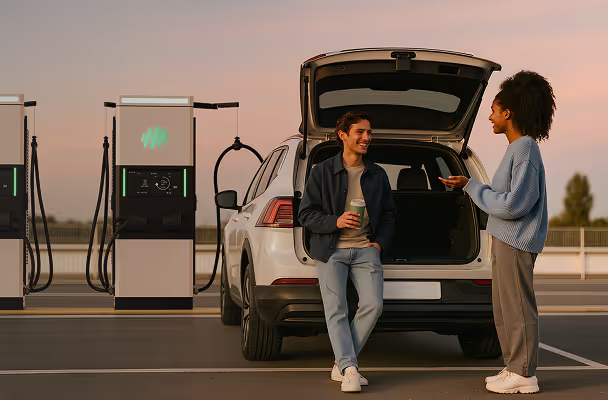8 Things to look for before buying Home EV Charger

After installing over 1.75 lakh EV chargers across India, there’s one pattern we’ve seen time andagain:
Most first-time EV buyers focus heavily on the vehicle — range, battery size, brand. And that makessense. But once the novelty wears off, it’s the charging experience that truly shapes day-to-daysatisfaction.
Here’s what the pros understand:
The charger isn’t just an accessory. It’s the bridge between your EV and your energy ecosystem. Theright charger can save money, reduce hassle, and future-proof your setup.
In this blog, we’ve distilled insights from years of ground-level experience into 8 practical EV chargerspecifications that seasoned EV users consider — but most new buyers overlook. These tips will helpyou make a smarter, long-term charging decision.
1. Charger Power Output & Vehicle Acceptance Rate
When selecting a home EV charger in India, it's vital to recognize that charging speed depends onboth the charger's rated output and the vehicle's onboard AC charger capacity. Most mass-marketIndian EVs like the Tata Nexon EV or MG ZS EV have onboard chargers capped at 3.3kW to 7.2kW,making higher-capacity AC chargers (11kW or 22kW) underutilized in home settings. Since mostIndian homes operate on single-phase connections, investing in higher-capacity chargers offers littlepractical advantage and can lead to unnecessary expense.
2. Multiple Connector Options or Swappable Cables
Future-proofing your charging setup is important in India, where connector standards vary. WhileType 2 and CCS2 are common, formats like Bharat AC001/DC001 are still in use. Chargers with multi-standard support, swappable cables, or dual ports offer versatility — ideal for homes with multipleEVs or real estate setups catering to various user needs. This flexibility ensures your setup evolvesalong with the market.
3. Smart Connectivity: Remote Monitoring & Scheduling
Smart chargers with Wi-Fi or Ethernet enable users to schedule ev charging during off-peak hours,reducing electricity costs. These chargers offer real-time monitoring, usage analytics, remotediagnostics, and alerts. Fleet operators and commercial facilities benefit from reduced downtime,while residential users enjoy better energy management and lower bills.
4. Load Balancing & Dynamic Power Management
In Indian settings with limited sanctioned load, especially in residential societies or shared spaces,dynamic load management is critical. Chargers with smart distribution systems adjust power basedon real-time consumption, preventing overloads and ensuring efficient charging across multiple vehicles. Some systems also prioritize solar input and allow user-defined scheduling, making themideal for sustainable operations.

5. Environmental Durability: Rated Operating Conditions
Given India's weather extremes, always choose chargers rated at least IP65 for water and dustresistance, with UV-stabilized enclosures for outdoor use. Tamper-proof, rust-resistant designs areessential for chargers in common or public areas. Durable units reduce maintenance, protect yourinvestment, and ensure reliable performance over the long term.
6. Form Factor: Wall-mounted, Pedestal, or Portable?
Wall-mounted ev charger units are suitable for garages or narrow spaces. Pedestal units work well in open areasor shared parking. Portable chargers offer convenience but are typically slower and not ideal for dailyuse. The right form factor depends on your layout, daily usage, and available electrical points. Alwaysmatch the design to your environment for optimal safety and convenience.
7. Universal Compatibility
Choose chargers that support open standards like OCPP and are tested across various EV brands. Thisensures compatibility across current and future EV models and prevents vendor lock-in. In India’s fast-changing market, universal compatibility guarantees software upgrade readiness and easyintegration with networked systems.
8. Finally and Most Importantly: Check Your Home’s Electrical Readiness
Installing a Level 2 charger isn't just about the charger itself — it depends heavily on your home'selectrical setup. These chargers often need a 200-amp panel, which may require upgrades in olderhomes. Consider the plug type, wiring distance, breaker compatibility, and future needs like solarintegration or bidirectional charging. Always use a certified electrician for installation to ensuresafety, efficiency, and long-term performance.
Bibliography
The Importance of EV Charging Analytics | Driivz
Effortless EV Charging | Real-Time Control - Seamless Payments - Scalable Solution | JioThings
Buy EV Charging Stations & Electric Car Chargers in India | Tobor
Bharat EV specifications for AC and DC charging - Everything you need to know!
Understanding Different Levels and Types of EV Charging Connectors
Power Management in EV Charging: Pioneering Efficiency and Speed for India’s Electric Mobility Future
Frequently Asked Questions
Lorem ipsum dolor sit amet, consectetur adipiscing elit, sed do eiusmod tempor incididunt ut labore et dolore magna aliqua. Ut enim ad minim veniam, quis nostrud exercitation ullamco laboris nisi ut aliquip ex ea commodo consequat. Duis aute irure dolor in reprehenderit in voluptate velit esse.
Lorem ipsum dolor sit amet, consectetur adipiscing elit, sed do eiusmod tempor incididunt ut labore et dolore magna aliqua. Ut enim ad minim veniam, quis nostrud exercitation ullamco laboris nisi ut aliquip ex ea commodo consequat. Duis aute irure dolor in reprehenderit in voluptate velit esse.
Lorem ipsum dolor sit amet, consectetur adipiscing elit, sed do eiusmod tempor incididunt ut labore et dolore magna aliqua. Ut enim ad minim veniam, quis nostrud exercitation ullamco laboris nisi ut aliquip ex ea commodo consequat. Duis aute irure dolor in reprehenderit in voluptate velit esse.
Lorem ipsum dolor sit amet, consectetur adipiscing elit, sed do eiusmod tempor incididunt ut labore et dolore magna aliqua. Ut enim ad minim veniam, quis nostrud exercitation ullamco laboris nisi ut aliquip ex ea commodo consequat. Duis aute irure dolor in reprehenderit in voluptate velit esse.
Lorem ipsum dolor sit amet, consectetur adipiscing elit, sed do eiusmod tempor incididunt ut labore et dolore magna aliqua. Ut enim ad minim veniam, quis nostrud exercitation ullamco laboris nisi ut aliquip ex ea commodo consequat. Duis aute irure dolor in reprehenderit in voluptate velit esse.




